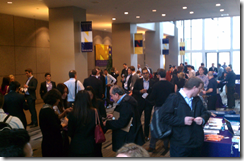In Lincoln Hall of the Northwestern School of Law, I felt like John Houseman (The Paper Chase, ‘78-‘86) would walk in and say “you’ll teach yourself the law, but I’ll train your minds […] if you survive, you’ll leave thinking like a lawyer.” Today we were not learning  tort and case law of the past, we were engaging in a different kind of survival – entrepreneurs creating the future.
tort and case law of the past, we were engaging in a different kind of survival – entrepreneurs creating the future.
Entrepreneurship Law Conference
The event was outstanding, well produced and focused on Entrepreneurship Law “Inc. to Empire: The Legal Growth Of Your Business.” Registration was my first surprise, I fully expected another plastic name badge holder – but found that a renewable (paper) agenda booklet with name-sticker was the I.D. du jour. [I cringe every time I receive a new plastic name badge and the event has no accommodation to  recycle/reuse. Paper is the way to go.] The conference ran 8:30AM to 4:00PM with healthy time for networking.
recycle/reuse. Paper is the way to go.] The conference ran 8:30AM to 4:00PM with healthy time for networking.
I want to share a few of the salient thoughts expressed in the meeting – I’ll try to keep it brief.
Session One – Attracting VC/Angel Funding
Darren Green, George Middlemas, Stuart Frankel, Troy Henikoff, Divya Narendra constituted a panel of experts. Troy does a great thing by disambiguating, and defining, abused terms enabling clarity for everyone. He started by clarifying the difference between an incubator and an accelerator. Incubators typically charge a fee for shared office space, paid for resources to enable a start-up to focus on starting up – often an incubator will optionally provide consulting, mentoring, and other guidance. Anyone can generally be part of an incubator, assuming there is space, and they have the money to pay. Accelerators, on the other hand are intensely focused on putting a start-up on a fast track to success. They are competitively selective in choosing who can participate. Instead of real estate being the core product, it is mentoring, formal training programs, and sometimes seed capital.
The most important point of the panel was to identify that the single most critical element in pitching to a VC or Angel for funding is to have traction. Traction is the measurable interest of a market or customer base. Not necessarily cash flow and revenue, but serious interest in real or potential customers that see the solution as something they will pay for to address their acute pain point. Sales or measurable market interest (that will lead to sales) is all too often not taken seriously enough. Every investor wants to see the “traction” story, crisp, clear, measurable, and above all, believable. Never again can we expect “ideas” to be funded. Entrepreneurs must validate their ideas with real “traction.”
Valuation was another interesting discussion. Not going into it here in detail, but another point made by the panel is that there is too much focus on “valuation.” Entrepreneurs get lost in the “number” somehow thinking that it is a measure of their own value, and may even lose focus on the fundamentals. The panel explained how special preferred investor options alter the meaning of any valuation raw number. The term sheet details can seriously affect (diminish for the entrepreneur, and amplify for investors) any meaning from a single “worth/value” number.
A question from the audience asked what Incubator’s look for, and what are red flags – the top 4 answers:
- GOOD: Team with diverse skills/background. BAD: Teams of one, or sole proprietors.
- GOOD: Team must have Technical Talent. BAD: Teams that outsource development.
- GOOD: Teams with entrepreneur experience. BAD: Teams with no one with experience.
- GOOD: Real run-rate or customer traction. BAD: Just an idea… (with no traction).
Session Two – The Process of An Initial Public Offering
Sarah Brooks Gabriel, David Fisher, James Rowe, Frank Petito, Jason Rice, and David Ruder convened a panel to provide insight into the process of tapping into public capital markets for funding. The focus was largely informing relative to the benefits, the reasons for choosing to IPO, or for choosing NOT to IPO. The audience learned a bit about the life after an IPO of living in a fishbowl with regulators and stakeholders watching every move; and, the headache that this entails.
George Middlemas from the first session made the point that IPO as an exit is typically for entrepreneurs that have gone big first. For example, the proof (another word for “traction”) that a company is ready to be a public company must exist, and in good volumes (number of customers, eyeballs, or plain revenue/cash flow). He contrasted this with the dot com era. Today, companies have to be BIG, like Facebook or Groupon, to successfully pull the IPO trigger. Odds are that most, and perhaps even everyone, in the room that day will never make it that big, and so should not be thinking IPO by default.
Session Three – How to Start a Business
There were two breakout sessions, the other on protecting your brand – a critically important topic, but I could only go to one, this one. The panelists in this session focused on their bits of history, pitfalls of learning, and wisdom gained from experience.
Best takeaway – love your lawyer and get it in writing sooner, always better than later.
Session Four – Keynote with Tom Churchill
Tom is an experienced executive, turned entrepreneur last year. When I say experienced, I mean, 30+ years in the corporate world. He is changing healthcare informatics with his medical records solution. Unspoken point one, it is never too late to become an entrepreneur!
Great words of wisdom in this interview-style keynote. Tom talked about customers, meeting with them, and engaging. The best anecdote I believe was Tom’s focus on sales, the act, and successful engagement, not revenue. He shared that the ability of the entrepreneurial team to close sales was critical. He pointed out in so many words that if you have a sales guy that is incapable of understanding the technology, demonstrate the product to customers, and close a deal, every deal, for some level of engagement – even if no money changes hands…, you have the wrong guy on your team. How did he share this? He gave examples of how he, with no sales experience, GOT sales experience, learned products, pitched, and closed deals. Even for unfinished product, you have to have a customer sign some level of deal that grows into traction, and fast – not years, but every week.
The conference is on my annual list. If these takeaways resonate with you – share your thoughts.









